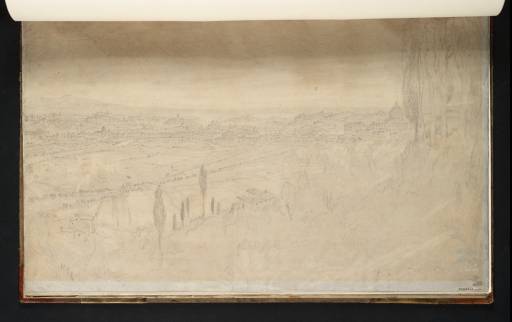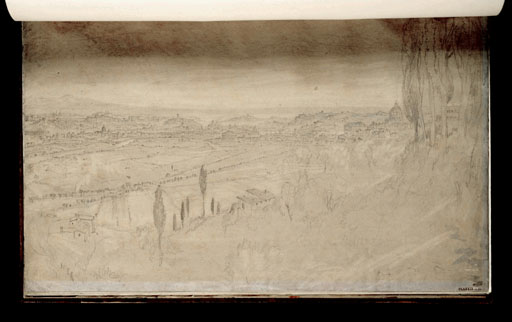Joseph Mallord William Turner View of Rome from the Villa Madama on Monte Mario 1819
Image 1 of 2
Joseph Mallord William Turner,
View of Rome from the Villa Madama on Monte Mario
1819
Joseph Mallord William Turner 1775–1851
Folio 31 Recto:
View of Rome from the Villa Madama on Monte Mario 1819
D16357
Turner Bequest CLXXXIX 31
Turner Bequest CLXXXIX 31
Pencil and grey watercolour wash on white ‘Valleyfield’ wove paper, 229 x 368 mm
Stamped in black ‘CLXXXIX 31’ bottom right
Stamped in black ‘CLXXXIX 31’ bottom right
Accepted by the nation as part of the Turner Bequest 1856
Exhibition history
1904
National Gallery, London, various dates to at least 1904 (590).
References
1903
Charles Holme, Robert de la Sizeranne, Walter Shaw Sparrow and others, The Genius of J.M.W. Turner, R.A., London, Paris and New York 1903, reproduced p.30, pl.53, as ‘View of Rome from Monte Mario’.
1904
E.T. Cook and Alexander Wedderburn (eds.), Library Edition: The Works of John Ruskin: Volume XIII: Turner: The Harbours of England; Catalogues and Notes, London 1904, no.590, pp.297, frame no.101, drawing no.221, 307, 334, 337, 636, as ‘View of Rome’ and ‘View of Rome from Monte Mario’.
1909
A.J. Finberg, A Complete Inventory of the Drawings of the Turner Bequest, London 1909, vol.I, p.563, as ‘View of Rome from Monte Mario. 590, N.G.’.
1909
?Sir Charles Holroyd, W[illiam] G[eorge] Rawlinson and Alexander J. Finberg, ‘The Watercolours of J.M.W. Turner’, London 1909 [special number of The Studio, Spring 1909], p.39.
1920
D[ugald] S[utherland] MacColl, National Gallery, Millbank: Catalogue: Turner Collection, London 1920, p.88.
1979
Andrew Wilton, The Life and Work of J.M.W. Turner, Fribourg 1979, p.383 under no.719.
1984
Cecilia Powell, ‘Turner on Classic Ground: His Visits to Central and Southern Italy and Related Paintings and Drawings’, unpublished Ph.D thesis, Courtauld Institute of Art, University of London 1984, pp.227–8, reproduced pl.151, as ‘Rome from Monte Mario’.
1987
Cecilia Powell, Turner in the South: Rome, Naples, Florence, New Haven and London 1987, pp.106, 109, reproduced p.[105] pl.113, as ‘Rome from Monte Mario’.
2000
Eric Shanes, Evelyn Joll, Ian Warrell and others, Turner: The Great Watercolours, exhibition catalogue, Royal Academy of Arts, London 2000, p.145 under no.52.
2008
Joanna Selborne, Andrew Wilton and Cecilia Powell, Paths to Fame: Turner Watercolours from The Courtauld Collection, exhibition catalogue, Wordsworth Trust, Grasmere 2008, pp.92, 95 note 2.
Some of the most famous panoramas of Rome could be seen from the heights of Monte Mario, a hill to the north of the city (for a general discussion see Tate D16174; Turner Bequest CLXXXVIII 9a). This sketch depicts the view looking south from a point near the Villa Madama, a sixteenth-century estate built for the Medici family on the eastern slopes, famous for its garden loggia designed by Raphael. The composition encompasses a sweep of approximately ninety degrees from the Esquiline Hill on the left, to St Peter’s on the right. Identifiable landmarks visible across the horizon include, from left to right: the obelisk of Piazza dell’Esquilino framed by the Church of Santa Maria Maggiore; the long stretch of the Quirinal Palace; the Colosseum; the Capitoline Hill; the Castel Sant’Angelo; San Giovanni dei Fiorentini, with the Aventine Hill beyond; San Pietro in Montorio on the Janiculum Hill; and on the far right; St Peter’s and the Vatican. Turner recorded the same viewpoint within the St Peter’s sketchbook (see Tate D16178–D16181; Turner Bequest 11a–13). He also made several alternative images featuring the view from Monte Mario within this sketchbook, see folios 33, 48, 57 and 60 (D16360, D16377, D16388, D16391) and loose sheets (D16337, D16342, D16350, D16352; CLXXXIX 11, 16, 24, 26).
As Cecilia Powell has discussed, the visual approach of depicting a distant prospect of the city from Monte Mario had a long artistic tradition.1 Turner may have known similar examples by his eighteenth-century landscape predecessors such as Richard Wilson’s Rome from the Villa Madama 1753 (Yale Center for British Art, New Haven),2 or John Robert Cozens’s, Rome from the Villa Mellini circa 1783–8 (Fitzwilliam Museum, Cambridge),3 whilst an example of a contemporaneous view in watercolour is by François Keiserman (1765–1833), Veduta di Roma e della Campagna da Monte Mario 1819 (private collection).4 The large number of detailed studies devoted to the subject within this sketchbook suggests that Turner was seriously exploring the idea as a potential theme for a painting. Indeed, the version on this page eventually provided the compositional basis for Rome, from the Monte Mario circa 1820–1 (private collection),5 one of a number of finished watercolours painted for Turner’s great friend and patron, Walter Fawkes, following the artist’s 1819 Italian tour. The topographical details, including the trees and buildings in the immediate foreground are extremely close to Turner’s original sketch. The artist has even indicated the same plume of smoke rising from the Viale Angelico, between the river and the small villa on the left.
Like many drawings within the Rome C. Studies sketchbook, the composition has been executed over a washed grey background and Turner has created areas of pale highlights within the sky and landscape by rubbing through to the white paper beneath. John Ruskin described the work as ‘exquisite’ and ‘a perfect example of Turner’s most deliberate pencil drawing’ for which ‘no terms of admiration can be too high’.6 He praised the accuracy of the details and the artist’s judgement in omitting ‘unhelpful’ objects.7 Finberg similarly described Turner’s 1819 views from Monte Mario as ‘exquisite’ pieces which had ‘long been among the most admired of the drawings exhibited in the Turner Water-Colour Rooms at the National Gallery’.8 Unfortunately, in common with many of the sketches and watercolours chosen for display during the late nineteenth and early twentieth centuries, it has suffered from overexposure to light and the paper has become irreversibly faded and discoloured. Peter Bower has suggested that this is probably down to the high content of indigo in the grey watercolour wash, rather than properties within the paper.9
Reproduced David Solkin, Richard Wilson, exhibition catalogue, Tate Gallery, London 1982, no.67, p.184.
Reproduced in colour in Pier Andrea de Roso e Paolo Emilio Trastulli, La Campania Romana da Hackert a Balla, exhibition catalogue, Museo del Corso, Roma 2001, no.2, p.[72].
Andrew Wilton, The Life and Work of J.M.W. Turner, Fribourg 1979, no.719. Reproduced in colour in Shanes Joll, Warrell et al 2000, no.52, p.145.
John Ruskin, Catalogue of the Sketches and Drawings by J.M.W. Turner, R.A. Exhibited in Marlborough House in the Year 1857–8, in Cook and Wedderburn (eds.) vol.XIII, p.297.
Verso:
Blank, except for traces of grey watercolour wash; stamped in black ‘CLXXXIX 31’ bottom left.
Nicola Moorby
July 2009
How to cite
Nicola Moorby, ‘View of Rome from the Villa Madama on Monte Mario 1819 by Joseph Mallord William Turner’, catalogue entry, July 2009, in David Blayney Brown (ed.), J.M.W. Turner: Sketchbooks, Drawings and Watercolours, Tate Research Publication, December 2012, https://www


